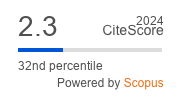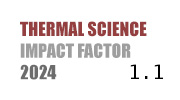THERMAL SCIENCE
International Scientific Journal
RAPID PREDICTION OF SOLID ROCKET IGNITION TRANSIENT PROCESS USING ARTIFICIAL NEURAL NETWORKS
ABSTRACT
Solid rocket motors have been a critical component of space exploration, military operations, and numerous other applications for decades. The ability to accurately predict the ignition transient behavior of solid rocket motors is crucial for ensuring safe and reliable operations. In this study, ANN are employed to predict the ignition transient process of a model solid rocket motor. The training and validation data for the ANN are obtained through simulations of a validated quasi-1-D model. Results show that with the inputs of axial co-ordinate and igniting time, the ANN can predict density, axial velocity, temperature, and pressure in internal ballistic within 0.039 relative error and a correlation coefficient above 0.994 compared to the quasi-1-D simulations in millisecond level. With the increase of hidden layers and neural numbers in the ANN, prediction accuracy increases. When the hidden layers exceed four, prediction accuracy cannot improve significantly. When test data is out of the temporal range of the training and validation data, prediction accuracy decreases evidently. The trained ANN model can be used to predict solid rocket motors with increased internal ballistic spatial resolution within 0.007 relative error and to predict solid rocket motors with increased temporal resolution within 0.107 relative error.
KEYWORDS
PAPER SUBMITTED: 2024-04-16
PAPER REVISED: 2024-06-20
PAPER ACCEPTED: 2024-07-02
PUBLISHED ONLINE: 2024-08-18
THERMAL SCIENCE YEAR
2025, VOLUME
29, ISSUE
Issue 1, PAGES [251 - 265]
- Summerfield, M., Solid Propellant Rocket Research, American Institute of Aeronautics and Astronautics, New York, USA, 1960
- d'Agostino, L., et al., An Ignition Transient Model for Solid Propellant Rocket Motors, Proceedings, 37th Joint Propulsion Conference and Exhibit, Salt Lake City, Ut., USA, 2001
- Vr Sanal Kumar, Raghunandan, B., Ignition Transient of Dual-Thrust Solid Propellant Rocket Motors - A Review, Proceedings, 48th AIAA/ASME/SAE/ASEE Joint Propulsion Conference & Exhibit, Atlanta, Geo., USA, 2012
- Tahsini, A. M., Ignition Transient Simulation in Solid Propellant Rocket Motors, Proceedings, 45th AIAA Aerospace Sciences Meeting and Exhibit, Reno, Nev., USA, 2007
- Francois, L., et al., A New Simulation Strategy for Solid Rocket Motor Ignition: Coupling a CFD Code with a One-Dimensional Boundary Flame Model, Verification Against a Fully Resolved Approach, Proceedings, AIAA Propulsion and Energy 2021 Forum, VIRTUAL EVENT, American Institute of Aeronautics and Astronautics, Reston, Va., USA, 2021
- Pardue, B., Han, S., Ignition Transient Analysis of a Solid Rocket Motor Using a One Dimensional Two Fluid Model, Proceedings, 28th Joint Propulsion Conference and Exhibit, Nashville, Tenn., USA
- Li, Y., et al., Fluid-Structure Coupled Simulation of Ignition Transient in a Dual Pulse Motor Using Overset Grid Method, Acta Astronautica, 183 (2021), June, pp. 211-226
- Cai, W., et al., A Model of AP/HTPB Composite Propellant Combustion in Rocket-Motor Environments. Combustion Science and Technology, 180 (2008), 12, pp. 2143-2169
- Gieras, M., Gorgeri, A., Numerical Modelling of the Hybrid Rocket Engine Performance, Propulsion and Power Research, 10 (2021), 1, pp. 15-22
- Hegab, A. M., et al., Numerical Modeling for the Combustion of Simulated Solid Rocket Motor Propellant, Computers & Fluids, 89 (2014), Jan., pp. 29-37
- Ma, Y., et al., A Model for Igniter Mass-flow Rate History Evaluation for Solid Rocket Motors, International Journal of Aerospace Engineering, 2019, On-line first, doi.org/10.1155/2019/2593602
- Tola, C., Nikbay, M., Internal Ballistic Modeling of a Solid Rocket Motor by Analytical Burnback Analysis, Journal of Spacecraft and Rockets, 56 (2019), 2, pp. 498-516
- Rohini, D., et al., Design & Analysis of Solid Rocket Using Open Rocket Software, Materials Today: Proceedings, 64 (2022), Part 1, pp. 425-430
- Hartfield, R., et al., A Review of Analytical Methods for Solid Rocket Motor Grain Analysis, Proceedings, 39th AIAA/ASME/SAE/ASEE Joint Propulsion Conference and Exhibit, Huntsville, Ala., USA, 2003
- Hartfield, R., et al., Analytical Methods for Predicting Grain Regression in Tactical Solid-Rocket Motors. Journal of Spacecraft and Rockets, 41 (2004), 4, pp. 689-693
- Kashiwagi, T., et al., Experimental Study of Ignition and Subsequent Flame Spread of a Solid Fuel in a Hot Oxidizing Gas Stream, Combustion and Flame, 24 (1975), Feb., pp. 357-364
- Rasbash, D. J., A Flame Extinction Criterion for Fire Spread, Combustion and Flame, 26 (1976), Feb., pp. 411-412
- Fernandez-Pello, A., Williams, F. A., A Theory of Laminar Flame Spread Over Flat Surfaces of Solid Combustibles, Combustion and Flame, 28 (1977), Jan., pp. 251-277
- Alekseev, M. V., Averson, A. E., Mechanism of the Propagation of a Flame Over a Surface in a Counterflow of Gas, Combustion, Explosion, and Shock Waves, 15 (1979), 5, pp. 594-600
- Sirignano, W. A., A Critical Discussion of Theories of Flame Spread across Solid and Liquid Fuels, Combustion Science and Technology, 6 (1972), 1-2, pp. 95-105
- Fernandez-Pello, A. C., Flame Spread in a Forward Forced Flow, Combustion and Flame, 36 (1979), Jan., pp. 63-78
- Sanal Kumar, V. R., et al., Starting Transient Flow Phenomena in Inert Simulators of Solid Rocket Motors with Divergent Ports, Journal of Propulsion and Power, 22 (2006), 5, pp. 1138-1141
- Peretz, A., et al., Starting Transient of Solid-Propellant ocket Motors with High Internal Gas Velocities, AIAA Journal, 11 (1973), 12, pp. 1719-1727
- Abreu, J., et al., A Comprehensive Approach to Predict a Rocket's Impact with Stochastic Estimators and Artificial Neural Networks, IET Signal Processing, 15 (2021), 9, pp. 649-665
- Lee, H. S., et al., Neural Networks for the Burn Back Performance of Solid Propellant Grains, Aerospace Science and Technology, 137 (2023), 108283
- Lee, H. S., et al., Optimization of a Solid Rocket Motor Design through Neural Network-Assisted Performance Prediction, IEEE Transactions on Aerospace and Electronic Systems, 59 (2023), 6, pp. 8769-8781
- Jung, M. Y., et al., Dynamic Model and Deep Neural Network-Based Surrogate Model to Predict Dynamic Behaviors and Steady-State Performance of Solid Propellant Combustion, Combustion and Flame, 250 (2023), 112649
- Lee, B. J., et al., Adaptive Osher-Type Scheme for the Euler Equations with Highly Nonlinear Equations of State, Journal of Computational Physics, 246 (2013), Aug., pp. 165-183
- Williams, A., et al., A Machine Learning Approach for Solid Rocket Motor Data Analysis and Virtual Sensor Development, Proceedings, AIAA Propulsion and Energy 2020 Forum, VIRTUAL EVENT, American Institute of Aeronautics and Astronautics, Reston, Va., USA, 2020
- Hartfield, R. J., Carpenter, M., Statistical Learning for Solid Propellant Performance, Proceedings, AIAA Propulsion and Energy 2021 Forum, VIRTUAL EVENT, American Institute of Aeronautics and Astronautics, Reston, Va., USA, 2021
- Abell, M. L., Braselton, J. P., First-Order Ordinary Differential Equations, in: Differential Equations with Mathematica, Elsevier,Amsterdam, The Netherlands, 2016, pp. 45-131
- Clerc, S., Accurate Computation of Contact Discontinuities in Flows with General Equations of State, Computer Methods in Applied Mechanics and Engineering, 178 (1999), 3-4, pp. 245-255
- Johnsen, E.,On the Treatment of Contact Discontinuities Using WENO Schemes, Journal of Computational Physics, 230 (2011), 24, pp. 8665-8668
- Nasab, S. H., Vermeire, B. C., Third-Order Paired Explicit Runge-Kutta Schemes for Stiff Systems of Equations, Journal of Computational Physics, 468 (2022), 111470
- Abadi, M., et al., Tensorflow: Large-Scale Machine Learning on Heterogeneous Distributed Systems, Proceedings, 12th USENIX Symposium on Operating Systems Design and Implementation (OSDI 16), Savannah, Geo., USA, 2016

